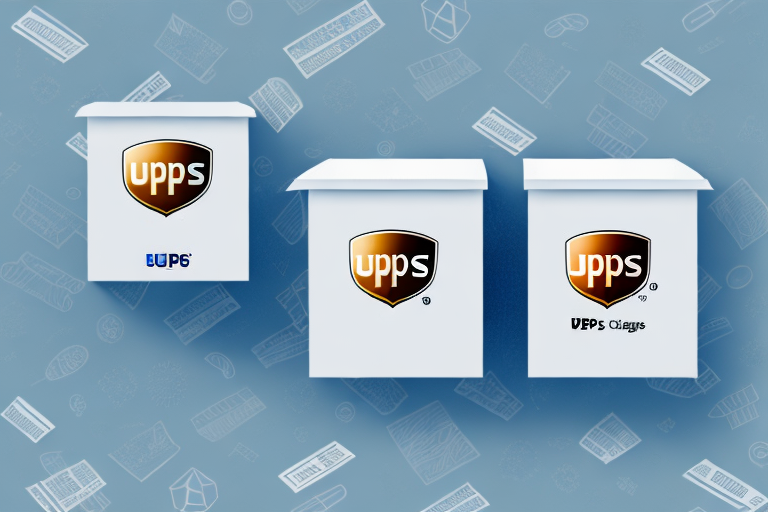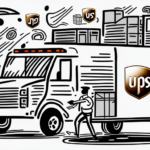Comparing UPS and USPS Rates for Shipping
When it comes to shipping, businesses and individuals have several options to choose from, including UPS and USPS. Understanding the differences between these two carriers can help you make the best choice for your specific needs and budget.
Understanding the Different Shipping Options Offered by UPS and USPS
Both UPS and USPS offer a variety of shipping options to cater to different needs:
- Ground Shipping: Ideal for non-urgent shipments. UPS Ground typically delivers within 1-5 business days, while USPS Retail Ground takes 2-8 business days.
- Priority Shipping: Faster delivery options such as UPS 2nd Day Air or USPS Priority Mail, which generally deliver within 1-3 business days.
- Expedited Shipping: For time-sensitive packages, UPS offers Express services with overnight delivery, and USPS provides Priority Mail Express with guaranteed overnight delivery to most locations.
- International Shipping: Both carriers offer international services. UPS has a robust global network with expedited options, while USPS provides various international mail services.
- Flat Rate Shipping: USPS offers flat rate boxes that allow you to ship items at a fixed price regardless of weight (up to a certain limit), which can be cost-effective for heavier items.
Additionally, UPS provides air and ocean freight services for larger shipments, making it suitable for businesses requiring comprehensive logistics solutions.
Tracking Your Shipments with UPS and USPS
Both UPS and USPS offer online tracking services to monitor your shipments. However, there are differences in the level of detail provided:
- UPS: Offers detailed tracking information with real-time updates on package location and estimated delivery times. You can track packages via the UPS Tracking page or mobile app.
- USPS: Provides tracking updates at key points in the delivery process, accessible through the USPS Tracking tool. The frequency of updates may be less compared to UPS.
Cost Comparison: UPS vs USPS
The cost of shipping with UPS and USPS depends on various factors:
- Package Size and Weight: Larger and heavier packages generally cost more to ship. USPS flat rate options can be economical for heavier items within their size limits.
- Shipping Speed: Faster delivery options come at a higher cost. UPS Express services are typically more expensive than USPS Priority Mail Express.
- Destination: Domestic shipments may be cheaper with USPS, especially for smaller packages, while international rates can vary based on the destination country and service chosen.
- Additional Services: Services like insurance, signature confirmation, and special handling can add to the overall cost.
To determine the most cost-effective option, it’s essential to compare rates using the respective carriers’ rate calculators:
Factors Determining the Cost of Shipping with UPS and USPS
The cost of shipping with UPS and USPS is influenced by several factors:
- Weight and Dimensions: Heavier and larger packages incur higher shipping costs.
- Distance: Longer shipping distances increase the cost.
- Shipping Speed: Faster delivery options are more expensive.
- Additional Services: Options like insurance, tracking, and signature confirmation add to the cost.
- Package Type: Special items such as hazardous materials or fragile items may require additional handling, increasing the cost.
- Seasonal Demand: During peak seasons like holidays, shipping rates may rise due to increased demand.
Understanding these factors can help you anticipate shipping costs and choose the most appropriate service.
The Pros and Cons of Using UPS for Shipping
- Pros:
- Reliable and detailed tracking information.
- Wide range of shipping options, including international services.
- Advanced logistics and freight services suitable for businesses.
- Commitment to sustainability with initiatives like alternative fuel vehicles.
- Cons:
- Can be more expensive for smaller packages compared to USPS.
- Strict package size and weight restrictions may limit shipping options.
The Pros and Cons of Using USPS for Shipping
- Pros:
- Affordable rates, especially for smaller packages and flat rate options.
- Extensive network of post offices and drop-off locations.
- Diverse shipping options tailored to different needs, including Priority Mail and First-Class Mail.
- Cons:
- Delivery times may be less reliable compared to UPS.
- Tracking information is less detailed.
- Limited advanced shipping services for businesses.
How to Choose Between UPS and USPS for Your Shipping Needs
When deciding between UPS and USPS, consider the following:
- Shipping Requirements: For international shipments or advanced logistics, UPS might be preferable. For domestic and smaller packages, USPS could be more cost-effective.
- Budget: Compare rates using the carriers’ online calculators to find the most affordable option for your needs.
- Delivery Time: If expedited delivery is crucial, UPS offers faster services. For standard shipping, USPS provides economical options.
- Destination: USPS has a broader reach in rural areas, while UPS may offer better service in urban regions.
By evaluating these factors, you can make an informed decision that aligns with your shipping priorities.
Factors to Consider When Deciding Between UPS and USPS for Shipping
- Delivery Speed: Determine how quickly your package needs to arrive.
- Package Size and Weight: Larger and heavier packages may be more cost-effective with USPS flat rates or UPS Ground.
- Additional Services: Consider if you need insurance, signature confirmation, or special handling.
- Carrier Reliability: Assess the reliability and customer service reputation of each carrier.
- Destination: International vs. domestic shipping needs can influence your choice.
Tips for Saving Money on Shipping Costs with UPS and USPS
- Compare Rates: Use rate calculators to find the most affordable option for your shipment.
- Take Advantage of Discounts: Both UPS and USPS offer discounts for bulk shipping and regular customers.
- Efficient Packaging: Use the smallest and lightest packaging possible to reduce costs.
- Use Free Shipping Supplies: Both carriers offer free boxes, envelopes, and labels which can help save on packaging costs.
- Enroll in Loyalty Programs: Programs like UPS My Choice or USPS Commercial Pricing can provide ongoing savings.
How to Track Your Packages with UPS and USPS
Tracking your packages ensures you stay informed about their status:
- UPS: Enter your tracking number on the UPS Tracking page or use the UPS mobile app. UPS also offers text and email notifications for real-time updates.
- USPS: Use the tracking number on the USPS Tracking tool. USPS may offer email notifications for updates.
While UPS provides more detailed tracking information, USPS offers sufficient tracking for most standard shipments. Choose the carrier that best fits your tracking needs.
Understanding Insurance Options with UPS and USPS
Insuring your packages protects against loss or damage during transit:
- UPS Insurance: Known as declared value coverage, UPS offers protection up to the declared value of the package. This option is available for an additional fee and excludes certain items like jewelry, antiques, and artwork.
- USPS Insurance: USPS offers insurance coverage based on the actual value of the package. Coverage limits vary depending on the service chosen, and certain high-value items may require additional coverage.
Before selecting an insurance option, review the carriers’ terms and conditions to ensure your items are adequately protected.
Comparing Delivery Times: UPS vs USPS
Delivery times vary based on the service selected and the destination:
- UPS: Offers a range of delivery options including Ground (1-5 business days), 2nd Day Air, and Next Day Air for faster deliveries.
- USPS: Provides services like Priority Mail (1-3 business days) and Priority Mail Express (overnight delivery to most locations).
Generally, UPS tends to offer faster delivery for domestic packages, especially for expedited services. However, USPS can be competitive for both domestic and international deliveries, particularly with their Priority Mail Express service.
Additionally, UPS provides comprehensive tracking and delivery guarantees, making it a reliable choice for time-sensitive shipments. USPS offers reliable services with extensive coverage, though tracking details may be less granular.
Differences Between Domestic and International Shipping Rates with UPS and USPS
Shipping rates for domestic and international destinations differ between UPS and USPS:
- Domestic Shipping: USPS is often more cost-effective for smaller and lighter packages. UPS may offer better rates for larger or heavier shipments, especially with their Ground services.
- International Shipping: UPS generally has higher rates due to its advanced international logistics and faster delivery options. USPS provides various international services that can be more affordable for standard shipping needs.
When shipping internationally, consider the destination country’s customs regulations and the carrier’s experience in handling international shipments.
How to Ship Hazardous Materials with UPS or USPS
Shipping hazardous materials requires adherence to strict guidelines to ensure safety and compliance:
- UPS: Requires proper labeling and documentation for hazardous materials. Only certain types of hazardous items are permitted, and specific packaging standards must be met. Refer to the UPS Hazardous Materials Shipping Guide for detailed requirements.
- USPS: Similar to UPS, USPS has strict regulations for shipping hazardous materials. Not all hazardous items are permitted, and proper packaging and labeling are mandatory. Visit the USPS Hazardous Mailing Information for more details.
Always consult the carriers’ official guidelines before attempting to ship hazardous materials to ensure compliance and safety.
Choosing the Right Packaging Materials for Your Shipment with UPS or USPS
Proper packaging ensures your shipment arrives safely and can help minimize costs:
- Select Appropriate Box Size: Use the smallest box that fits your item securely to reduce shipping costs.
- Use Quality Packaging Materials: Invest in sturdy boxes, bubble wrap, packing peanuts, and strong tape to protect your items.
- Secure Your Items: Ensure that items are well-protected and do not move within the package.
- Label Clearly: Clearly print both sender and recipient addresses. Avoid placing labels over seams or closures.
Both UPS and USPS offer a range of packaging materials for purchase, including boxes, envelopes, and padded mailers. Utilizing carrier-provided packaging can sometimes offer cost advantages and ensure compliance with shipping standards.
Best Practices for Labeling Your Packages When Using UPS or USPS
Proper labeling is crucial for ensuring prompt and accurate delivery:
- Include Full Addresses: Clearly write or print the recipient’s full name, street address, city, state, and ZIP code. Include your return address as well.
- Use Legible Fonts: Ensure that all text is clear and easy to read to prevent misdelivery.
- Avoid Obstructions: Do not place labels over package seams, closures, or any other areas that might obscure important information.
- Special Instructions: If there are any special handling instructions or delivery requirements, clearly mark them on the package.
- Use Barcode Labels: Utilize barcode labels provided by the carrier to facilitate tracking and sorting.
Adhering to these best practices can significantly reduce the risk of delivery issues and ensure that your packages reach their intended recipients efficiently.
Conclusion
Choosing between UPS and USPS depends on your specific shipping needs, budget, and priorities. Both carriers offer a range of services tailored to different requirements. By understanding the differences in their shipping options, costs, delivery times, and additional services, you can make an informed decision that best suits your shipping objectives.
For more detailed comparisons and to get the most accurate rates, visit the official UPS and USPS websites.






